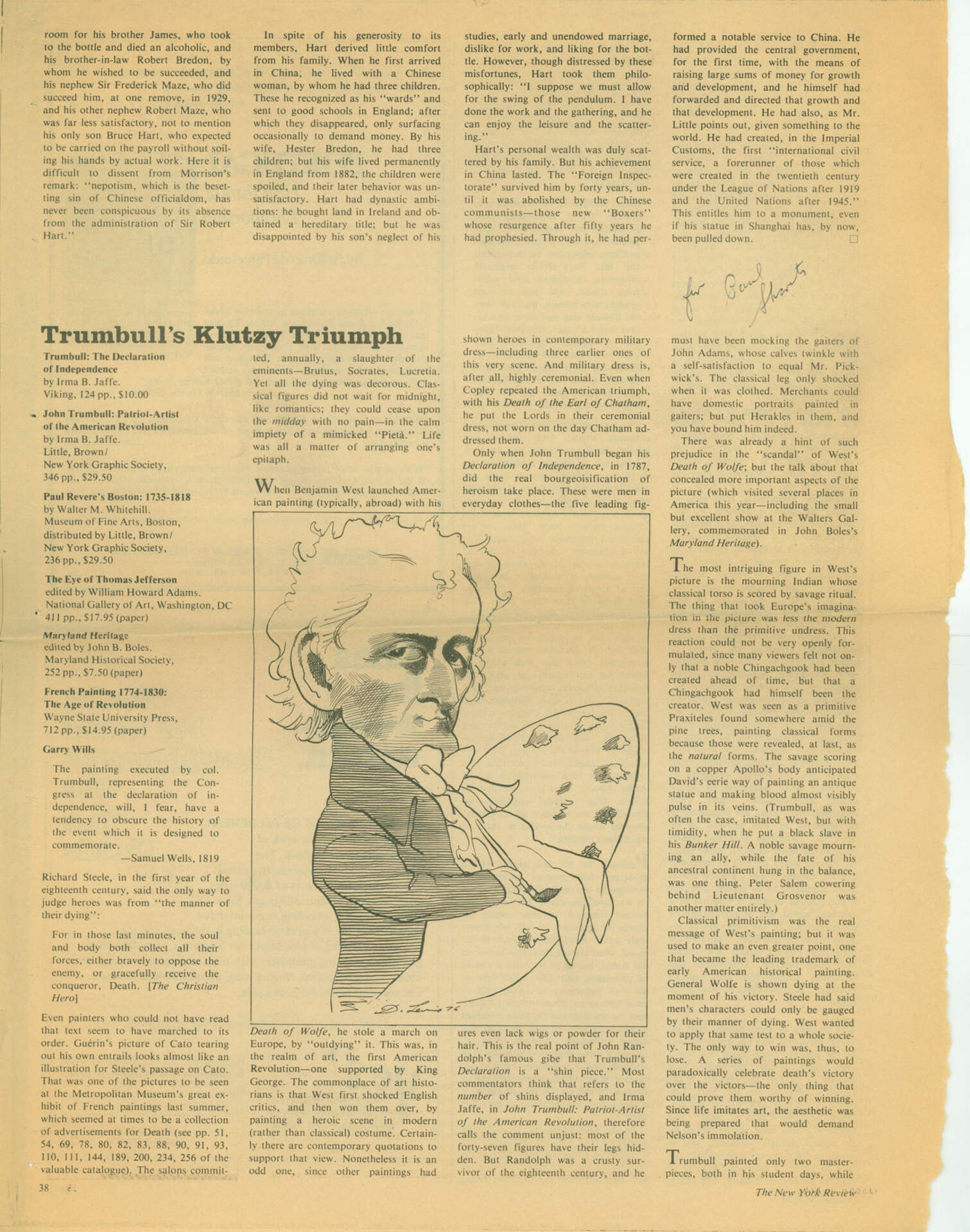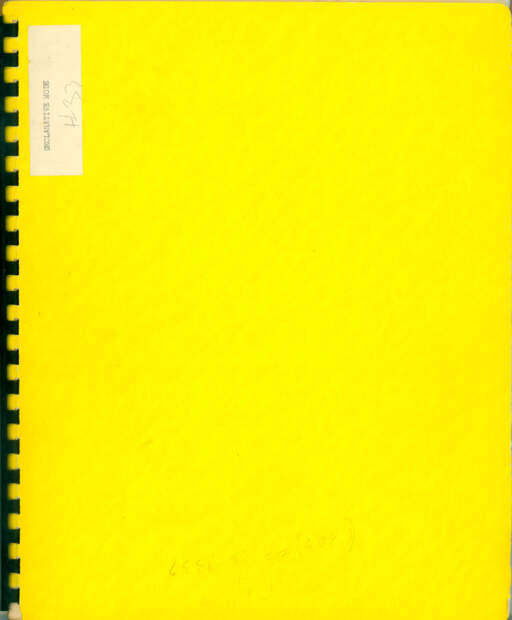Paul Sharits (1943-1993)Trumbull's Klutzy Triumph
Newspaper article
15 x 11 1/2 inches
Gift of Christopher and Cheri Sharits, 2006
Trumbull’s Klutzy Triumph
Trumbull: The Declaration of Independence by Irma B. Jaffe.
Viking, 124 pp., $10.00
John Trumbull: Patriot-Artist of the American Revolution by Irma B. Jaffe.
Little, Brown/ New York Graphic Society, 236 pp., $29.50
The Eye of Thomas Jefferson edited by William Howard Adams.
National Gallery of Art, Washington DC, 411 pp., $7.50 (paper)
French Painting 1774-1830: The Age of Revolution
Wayne State University Press, 712 pp., $14.95 (paper)
Gary Wills
The painting executed by col. Trumbull, representing the Congress at the declaration of independence, will, I fear, have a tendency to obscure the history of the event which it is designed to commemorate.
-Samuel Wells, 1819
Richard Steele, in the first year of the eighteenth century, said the only way to judge heroes was from “the manner of their dying”:
For in those last minutes, the soul and body both collect all their forces, either bravely to oppose the enemy, or gratefully receive the conqueror, Death. [The Christian Hero]
Even painters who could have not read that text seem to have marched to its order. Guerin’s picture of Cato tearing out his own entrails looks almost like an illustration of Steele’s passage on Cato. That was one of the pictures to be seen at the Metropolitan Museum’s great exhibit of French paintings last summer, which seemed at times to be a collection of advertisements for death (see pp. 51, 54, 69, 80, 82, 83, 88, 90, 91, 93, 110, 111, 144, 189, 200, 234, 256 of the valuable catalogues). The salons committed, annually, a slaughter of the eminents—Brutus, Socrates, Lucretia. Yet all the dying was decorous. Classical figures did not wait for midnight, like romantics; they could cease upon the midday with no pain—in the calm impiety of a mimicked “Pieta.” Life was all a matter of arranging one’s epitaph.
When Benjamin West launched American painting (typically, abroad) with his Death of Wolfe, he stole a march on Europe, by “outdying” it. This was, in the realm of art, the first American revolution—one supported by King George. The commonplace of art historians is that west first shocked English critics, and then won them over, by painting a heroic scene in modern (rather than classical) costume. Certainly there are contemporary quotations to support that view. Nonetheless it is an odd one, since other paintings had shown heroes in contemporary military dress—including three earlier ones of this very scene. And military dress is, after all, highly ceremonial. Even when Copely repeated the American triumph, with his Death of the earl of Catham addressed them.
Only when John Trumbull began his Declaration of Independence, in 1787, did the real bourgeoisification of heroism take place. These were real men in everyday clothes—the five leading figures even lack wigs or powder for their hair. This is the real point of john Randolph’s famous gibe that Trumbull’s Declaration is a “shin piece.” Most commentators think that refers to the number of shins displayed, and Irma Jaffe, in John Trumbull: Patriot-Artist of the American Revolution, therefore calls the comment unjust: most of the forty-seven figures have their legs hidden. But Randolph was a crusty survivor of the eighteenth century, and he must have been mocking the gaiters of John Adams, whose calves twinkle with a self-satisfaction to equal Mr. Pickwick’s. The classical leg only shocked when it was clothed. Merchants could have domestic portraits painted in gaiters; but in Herakles in them, and you have bound him indeed.
There are already a hint of such prejudice in the “scandal” of West’s Death of Wolfe; but the talk about that concealed more important aspects of the picture (which visited several places in America this year—including the small but excellent show at the Walters Gallery, commemorated in John Bole’s Maryland Heritage).
The most intriguing figure in West’s picture is the mourning Indian whose classical torso is scored by savage ritual. The thing that took Europe’s imagination in the picture was less the modern dress than the primitive undress. This reaction could not be very openly formulated, since many viewers felt not only that a noble Chingachgook had been created ahead of time, but that a Chingachgook had himself been the creator. West was seen as a primitive Praxitles found somewhere amid the pine trees, painting classical forms because those were revealed, at last, as the natural forms. The savage scoring on a copper Apollo’s body anticipated David’s eerie way of painting an antique statue and making blood almost visibly pulse in its veins. (Trumbull, as was often the case, imitated West, but with timidity, when he put a black slave in his Bunker Hill. A noble savage mourning an ally, while the fate of his ancestral continent hung in the balance, was one thing. Peter Salem cowering behind Lieutenant Grosvenor was another matter entirely.)
Classical primitivism was the real message of West’s painting; but it was used to make an even greater point, one that became the leading trademark of early American historical painting. General Wolfe is shown dying at the moment of his victory. Steele had said men’s character could only be gauged by their manner of dying. West wanted to apply that same test to a whole society. The only way to win was, thus, to lose. A series of paintings would paradoxically celebrate death’s victory over the victors—the only thing that could prove them worthy of winning. Since life imitates art, the aesthetic was being prepared that would demand Nelson’s immolation.
Trumbull painted only two masterpieces, both in his student days, while


